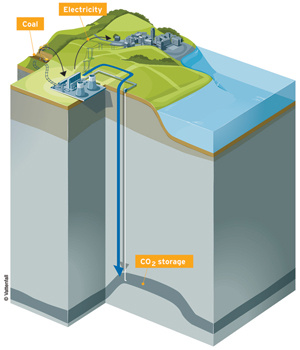Reducing coal emission
ECO Intelligence. Coal is one of the most widely used fossil fuels on the planet – and probably the dirtiest. So what is the future of coal in a world energy picture dominated by environmental concerns? Minestories examines the issue.
Coal has been around since prehistoric people used it to heat their caves. The fossil fuel drove the Industrial Revolution in Europe and the United States, where it remains the top power source, producing as much as 70 percent of all electricity. Coal is also spurring development and prosperity in the fast-emerging economies of China, India and elsewhere.
On the downside, coal-fired plants in the United States alone have been estimated to emit around 2.5 billion tonnes of carbon dioxide every year, leading to predictions about the imminent demise of coal due to environmental concerns and the surge of nuclear power and renewable energy sources.
Reducing emissions
Many European energy policy makers see CCS and its potential of capturing at least 90 percent of CO2 emissions as the only realistic alternative for fossil fuels to meet the long-term goal of reducing greenhouse gas emissions by 2050.
Nonetheless, despite causing the highest CO2 emissions of all fossil fuels, old king coal is alive and well. Almost all international energy organizations and experts predict it will play the major role in the world’s energy supply for decades to come. Coal is playing a large role in the economic expansion of most emerging economies such as China, Brazil, Russia and India. In its 2011 World Energy Outlook, the U.S. Energy Information Administration (EIA) forecasts coal will continue to reign as the world’s largest source of power in 2035.
Although coal use is expected to decline in developed countries, there are anomalies. In Germany, for example, coal is suddenly back on the agenda as the country accelerates away from nuclear energy in the wake of the Fukushima nuclear crisis in Japan. According to Professor Karl Rose, director of policies and scenarios at the World Energy Council and one of Europe’s leading energy experts, governments everywhere are being confronted with the “trifecta” of finding a way to balance the core issues of energy security, affordability and environment.
“Coal has been a very attractive source of energy for generations and remains so for very good accessibility and economic reasons,” Rose says. On the other hand, he says there is no avoiding the credible arguments by coal’s opponents that it remains a dirty source of power.
 Efforts to reduce the impact of coal mining are focused largely today on tackling CO2 emissions, which has spawned the idea of “green” or clean coal, according to Rose.
Efforts to reduce the impact of coal mining are focused largely today on tackling CO2 emissions, which has spawned the idea of “green” or clean coal, according to Rose.
“It is not easy for heavy industry to switch away from carbon fossil fuels,” Rose says. “Electricity production and steel making are dependent for their survival on competitive pricing, security of availability and environmental impact. When it comes to coal, we can assure the first two already today in Europe, which is why the European focus now is on the third issue, our environment.”
The silver bullet being touted as the solution to allow ongoing use of fossil fuels such as coal without letting the carbon enter the atmosphere is known as carbon capture and storage, or CCS.
The principle involves using existing technologies to capture, transport and store carbon dioxide emissions from sources such as power stations and steel mills. The captured carbon would be buried deep underground in aquifers or in disused oil fields, where perhaps it could be used to help force out oil that is difficult to extract. Rose stresses the fact that the whole issue of global energy is too complex for one single solution.
“Carbon capture is an important step to achieving a balanced energy mix,” he says. “While it is true that CCS will contribute to creating a ‘green coal’ world, our focus must be on successfully meeting the tripartite goals of economic growth, energy security and reduced environmental impact.”
David Noble

/https%3A%2F%2Fsolidground.sandvik%2Fwp-content%2Fuploads%2F2012%2F06%2Fthequest-main.jpg)
/https%3A%2F%2Fsolidground.sandvik%2Fwp-content%2Fuploads%2F2019%2F10%2F47246191292_1600x570.jpg)
/https%3A%2F%2Fsolidground.sandvik%2Fwp-content%2Fuploads%2F2019%2F10%2FHenrik_Ager_foto_oskar_omne0015_1600x570.jpg)
/https%3A%2F%2Fsolidground.sandvik%2Fwp-content%2Fuploads%2F2019%2F10%2FGearingUp_1600x570.jpg)
/https%3A%2F%2Fsolidground.sandvik%2Fwp-content%2Fuploads%2F2019%2F08%2FBasic_1600x570-Greenwood-02.jpg)
/https%3A%2F%2Fsolidground.sandvik%2Fwp-content%2Fuploads%2F2019%2F04%2FIll-Sandvik-SustainMining_part2.jpg)
/https%3A%2F%2Fsolidground.sandvik%2Fwp-content%2Fuploads%2F2018%2F11%2FVamos-01_1600x570.jpg)
/https%3A%2F%2Fsolidground.sandvik%2Fwp-content%2Fuploads%2F2018%2F06%2FGhana_01_1600x570.jpg)
/https%3A%2F%2Fsolidground.sandvik%2Fwp-content%2Fuploads%2F2018%2F02%2FBorden-Lake_1600x570_02.jpg)
/https%3A%2F%2Fsolidground.sandvik%2Fwp-content%2Fuploads%2F2017%2F08%2FPractice_Safety_1_1600x570.jpg)
/https%3A%2F%2Fsolidground.sandvik%2Fwp-content%2Fuploads%2F2017%2F05%2FMiners-going-green_1600x570.jpg)
/https%3A%2F%2Fsolidground.sandvik%2Fwp-content%2Fuploads%2F2017%2F03%2FSafety-HX900_1600x570_04.jpg)
/https%3A%2F%2Fsolidground.sandvik%2Fwp-content%2Fuploads%2F2017%2F03%2FFirst-all-electric-mine_1600x750.jpg)